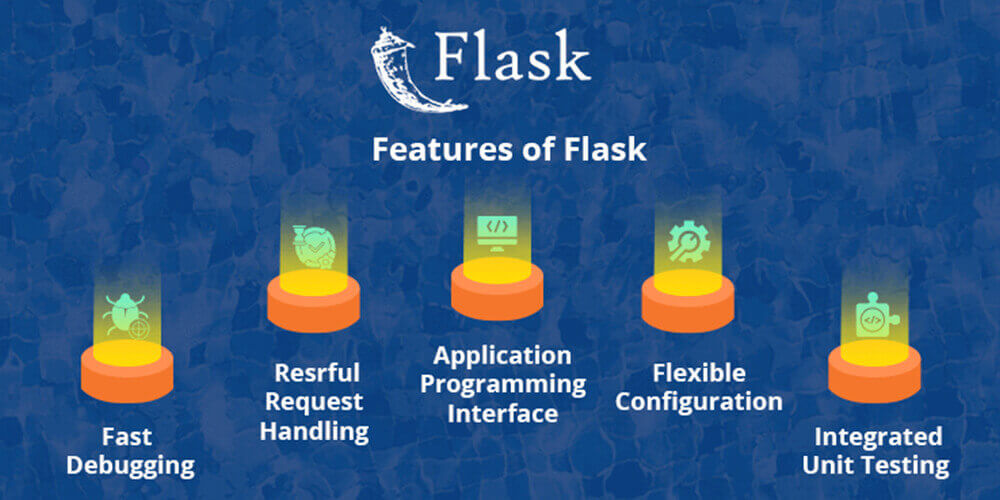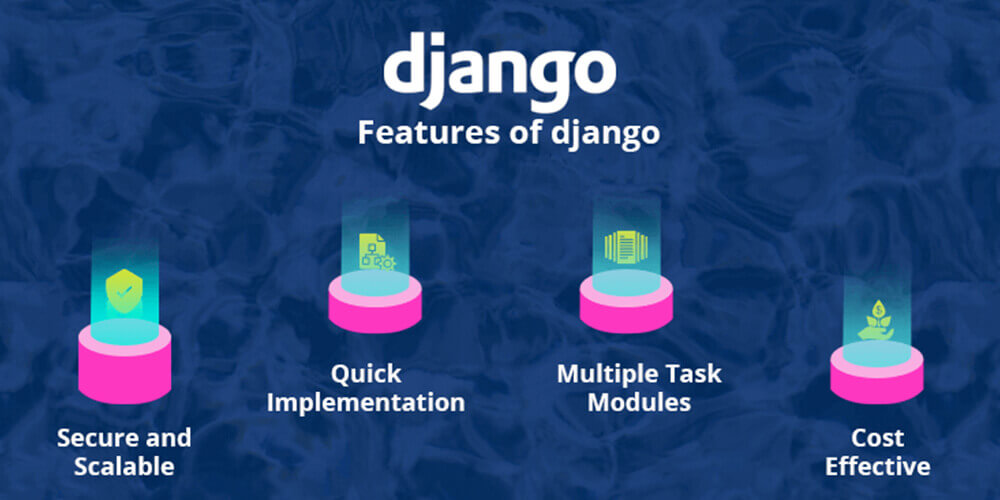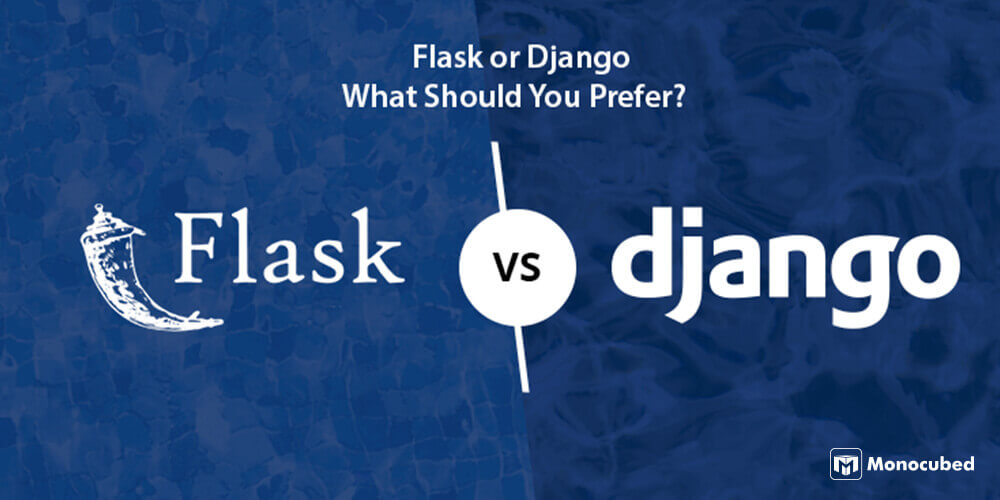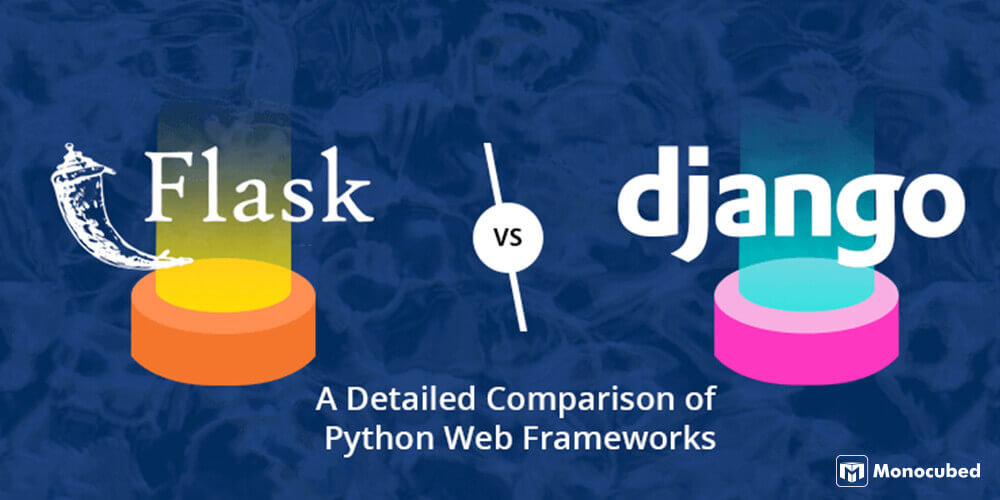The web developers have varied options to select from a huge range of web frameworks when employing Python as the server-side programming language. They can take the benefit of full-stack Python frameworks to accelerate the development of huge and complex web applications by getting several robust tools and features.
Both Flask and Django, are enormously popular amongst Python programmers. Django is a full-stack Python framework, while Flask is an extensible python lightweight web framework. Here, from Flask vs Django, let’s understand the major differences between these two frameworks.
Table of Content
Flask At A Glance
Flask is a web framework that is written in Python. It is categorized as a micro framework as it does not need specific libraries or tools. It contains no database abstraction layer, form validation, or any other elements where the existing third-party libraries offer common purposes.
Nevertheless, Flask supports the extensions that may add a framework, comprising LinkedIn and Pinterest application characteristics as if they were executed in Flask itself.
Extensions are available for form validation, object-relational mappers, various open authentication technologies, upload handling, and numerous general framework-associated tools. Flask is an API of the Python programming language that permits the development of web applications.
It was created by Armin Ronacher, who managed a group of international Python supporters called Poocco.
It is easier to learn as it has less base code to devise a simple application. Flask is constructed on Jinja2 template engine and Web Server Gateway Interface (WSGI) toolkit. Applications that utilize the Flask web framework comprise LinkedIn and Pinterest.
Features of Flask

Flask has turned out to be prevalent amongst Python enthusiasts. It has the second most stars on GitHub amongst Python web development frameworks, as of October 2020 and was chosen as the most popular web framework in Python Developers Survey 2018.
Below are some of the vital features that depict what is Flask used for:
- Flask comes with a fast debugger and inbuilt development server
- It renders you the complete control of choices to develop the application during the implementation step
- It has HTTP and RESTful request handling
- It comprises two core dependencies – Jinja2 and Werkzeug that offer sturdy WSGI support and templates
- This framework contains a coherent and neat Application Programming Interface (API)
- Flask framework has flexible and easy configurations
- It renders an integrated unit testing support
Have a Web App Idea in Mind?
We are interested. Be it a simple web app for your startup or a complex enterprise solution, our Python developers can help develop it.
Django At A Glance
Django is a free to use framework that works on the model-template-view (MTV) architectural design. This Python-based web framework is preserved by the Django Software Foundation (DSF), an American autonomous body established as a 501(c)(3) non-profit.
Django’s principal objective is to simplify the formation of multifaceted, database-driven websites.
The open-source framework accentuates pluggability and reusability of components, low coupling, rapid development, less code, and the norm of don’t repeat yourself (DRY). Python is used throughout the process, even for setting data models and files.
Django also delivers an elective administrative create, update, read, and delete user interface that is produced vigorously through contemplation and configured by the means of admin models.
Some of the well-known sites that exercise Django are Instagram, PBS, The Washington Times, Mozilla, Bitbucket, Nextdoor, and Disqus.
You may also like: Django Vs Express: 11 Key Differences To Observe
Features of Django

Django is a web framework for Python which renders a classic technique for effective and fast website development. In 2003, it was started by Simon Willison and Adian Holovaty as an in-house project at Lawrence Journal-World newspaper. It was publicly released under the BSD license.
This framework was entitled after guitarist Django Reinhardt in July 2005. Below mentioned are a few important features of Django:
- Django delivers utmost security and aids a web developer to evade many general security mistakes, such as cross-site scripting, SQL injection, and cross-site request forgery. Here, the user authentication scheme gives a secure way to manage passwords as well as user accounts.
- It was intended to create a framework that takes less time to develop web applications. The project implementation stage is very time-consuming, but Django produces it quickly.
- It includes various helping task modules and libraries which can be used to handle common Web development tasks. Django takes into account user authentication, site maps, content administration, and RSS feeds.
- Django is an open-source framework. It is openly available without any cost. It can be downloaded with the source code from a public repository. Such an open-source lessens the total budget of any web application development.
- It is a scalable framework and can flexibly and quickly shift from small to large-scale web application projects.
- It is one of the most prevalent web frameworks. It has an extensive support community and channels to connect and share.
- This framework is versatile as it permits the creation of applications for different domains. These days many companies are using Django to form several kinds of applications namely, social network sites, content management systems, scientific computing platforms, to name a few.
Flask vs Django: Comparison of The Best Python Web Frameworks
Django is termed as a full-stack Python web framework. Furthermore, it is built based on batteries included. Such a method in Django makes it simpler for Django developers to achieve general web development errands like URL routing, user authentication, and database schema migration.
On the contrary, Flask is a lightweight, simple, and minimalist framework. Though it lacks some of the inbuilt traits supplied by Django, it assists the developers to keep the base of an application extensible and simple.
As a top Python development company in Canada, we use both Flask and Django in our projects. We have compiled this table to help you understand the difference between the best Python web frameworks – Flask and Django:
| Aspects | Flask | Django |
|---|---|---|
| Type of Framework | Flask is a lightweight framework with minimalistic characteristics. | Django is a full-stack framework that follows the batteries-included methodology. |
| Ready-to-use Feature | It does not have any ready-to-use feature to manage administrative tasks. | It comes with a readymade Django admin framework that can be easily customized. |
| Controlling | Developers can discover and keep control of the fundamentals of the application. | Developers already possess access to the most general features that make development quicker. |
| API support | It provides support for API. | It does not have support for API. |
| Template Engine + | Its template engine – Jinja2 is based on the template engine of Django. | It comes with an inbuilt template engine that saves much development time. |
| Admin Tool | Admin traits are not as prominent as in the Django framework. | The Django admin tool is an inbuilt bootstrapping tool with which its developers can form web applications without any exterior input. |
| Databases | Flask permits you to utilize manifold types of databases. | Django does not offer several kinds of databases. |
| Visual Debug | It supports Visual Debug. | It does not support Visual Debug. |
| Single Application | Every project can be a single application, though, manifold views and models can be added to a single application. | It permits the users to split a single project into numerous small applications which makes them simple to build and maintain. |
| Production-ready Framework | It is single-threaded and may not function very well under heavy pressure. | It is known as a production-ready framework. |
| Working Style | It supplies a diversified working style. | It presents a monolithic working style. |
| Variable | The request oriented object is imported from the Flask module, which is a comprehensive variable in Flask. | All the views are set as a separate parameter here. |
| Execute Database Tasks | Here, the developers have to function with dissimilar databases by utilizing ORM schemes for Python and SQLAlchemy as a SQL toolkit. SQL enquiries have to be written for general tasks. | The built in ORM system allows the developers to utilize any database and execute general database tasks without having to write any long queries. |
| Popularity | Flask is a good framework if you have just started with web development. There are several sites developed on Flask and gain substantial traffic, but not as much as compared to the ones built on Django. | Django is seen to be more popular because it delivers many incredible features and decreases time to form intricate applications. |
| Flexibility | The developers are free to utilize any libraries and plugins and flexibly build functionalities. | The developers cannot afford consistent flexibility because of the modules supplied by Django. |
| Alterations | Here, a simple app can be later altered to supply additional functionality and create it multifaceted. It delivers the flexibility to enlarge the app rapidly. | It is not appropriate for projects where the necessities alter dynamically. |
| Template Scheme | This web framework utilizes the Ninja2 template system. | This web framework aids you to use the View web templating design. |
| Third-party Applications | It does not provide support for third-party applications. | It supports an enormous number of third-party applications. |
| Lines of Code | Flask web app needs fewer lines of code for any simple task. | For similar functionality, Django requires more than two times more lines of code than the Flask framework. |
| URL Dispatcher | The URL dispatcher of this web framework is a RESTful request. | The URL dispatcher of this framework is based on controller-regex. |
Pros and Cons of Django
Django is one of the most prevalent web frameworks.It has an extensive support community and channels to connect and share.
Following are the advantages and disadvantages of Django:
- Provides an easy to utilize interface for several administrative events
- Simpler to set-up and execute
- Sanctions end-to-end web application testing
- Presents multilingual websites by employing its inbuilt internationalization scheme
- REST framework has much support for numerous authentication protocols
- Utilized for rate-limiting API request from a single user
- Allows to document API with HTML output
- Delivers inbuilt authentication arrangement
- Assists you to outline patterns for URLs in your application
- Considered as a high-level framework for fast web development
- Data exhibited with Python programs
- Cache framework has manifold cache devices
- Offers a whole stack of tools
- Has large a size of code
- Lesser design choices and components
- A monolithic platform
- Compatibility with modern technologies
- A huge reliance on Django ORM. Comprehensive knowledge is required
- An advanced entry point for simple resolutions
- Underpowered ORM and templating
- Much bloated for small schemes
- High learning curve
- Auto-reload restarts the whole server
- Only permits you to manage a single request at a given time
- You can organize components collectively, which can arise confusion
- Documentations does not consider real-world situations
- Interior sub-components coupling
- Routing needs some knowledge of general expressions
Want to Build A Custom Web App?
Get your idea validated by professionals. Discuss unique features to add. Know the cost of development. Know the timeframe. Let’s start building.
Pros and Cons of Flask
Flask is easier to learn as it has less base code to devise a simple application. It is constructed on Jinja2 template engine and Web Server Gateway Interface (WSGI) toolkit. Applications that utilize the Flask web framework comprise LinkedIn and Pinterest.
Following are the advantages and disadvantages of Flask:
- High scalability for simple applications
- Easier to employ for simple cases
- Codebase extent is moderately smaller
- Advanced compatibility with new technologies
- Technical research
- Routing URL is easy
- Easy to develop a rapid prototype
- Database integration is simpler
- Easy to build and retain applications
- Small base and effortlessly extensible
- Stacks of resources accessible online, particularly on GitHub
- Minimal, yet authoritative platform
- High maintenance charges for more multifaceted systems
- Slow MVP development in most of the cases
- Async can be a problem
- Complex maintenance for bigger implementations
- Supplies inadequate support and smaller community as compared to Django
- Setting-up any big project needs certain knowledge of this framework
- Lack of ORM and database
Flask or Django: What Should You Prefer?

Numerous developers have a common question, Django OR Flask – which framework is better? By now, from the difference between Django and Flask, you might have got a reasonable idea of how each framework functions and what are the benefits offered.
You must prefer Flask if you need a rough level of control whereas Django developers depend on an extensive community to create exceptional websites.
Django combined with the REST framework assists you to develop powerful APIs, while Flask needs more work, so there are higher chances to commit a mistake. The best way is to develop a few rudimentary CRUD applications with both the frameworks and choose which framework fits your project better.
Frequently Asked Questions
Is Flask easier than Django?
You can use complete Python, that is, customize the structure of your app. On the contrary, Flask might be complex to employ for beginners. Nevertheless, when it comes to learning the architecture of the framework, Flask is easier than Django.
Is Django the future?
While mentioning the future of web apps, Django has much to offer and can serve the modern web application structures. Utilizing the Django framework is one of the best methods to build modern web applications.
Is Flask a frontend or backend?
Flask is utilized for backend, but it makes usage of a templating language known as Jinja2 which is employed to create XML, HTML, or other mark-up formats that are reverted to the users via an HTTP request.
What is Flask in Python?
Flask is a lightweight Web Server Gateway Interface (WSGI) application framework. It started as a simple wrapper around Jinja and Werkzeug and has turned out to be one of the most popular Python frameworks. Flask proposes suggestions, but does not impose project layout or any dependencies.
Conclusion
From the above-stated table of Django vs Flask, the intention is not to assert that one framework is superior to the other. But it is to observe the vital points that will empower you to make an informed judgment, against the requirements of your project.
Both Python frameworks, Django and Flask, are suitable for quick web app development, although Django is said to have a steeper learning curve. Flask delivers the most flexibility in form of customization and Django has a bigger community of users and hence, provides more support.
However, if you are still confused, you can contact our proficient Python developers at Monocubed, where we develop a robust web application after considering the requirements of your project.
 By Jeel Patel
By Jeel Patel



